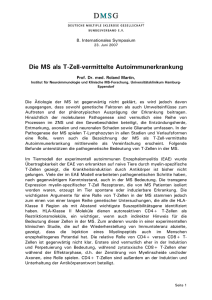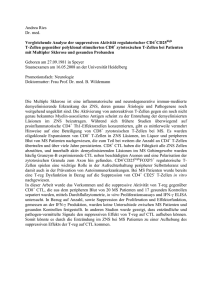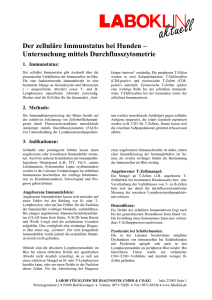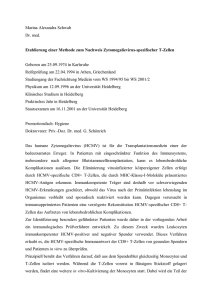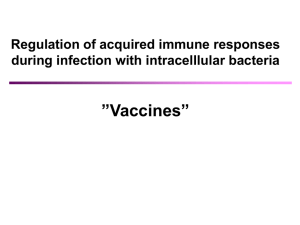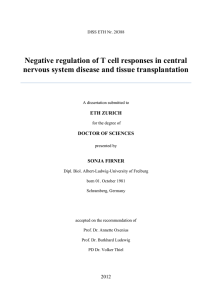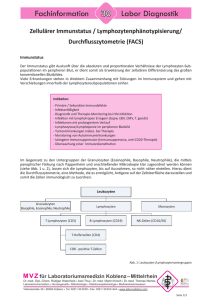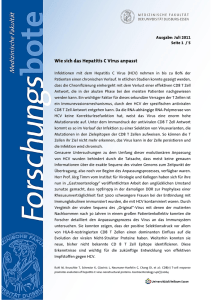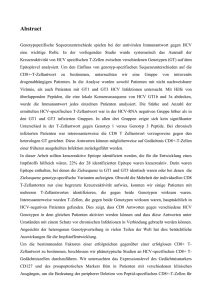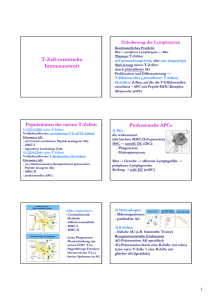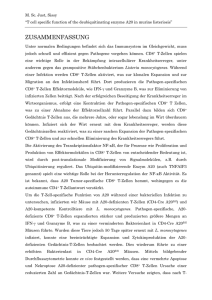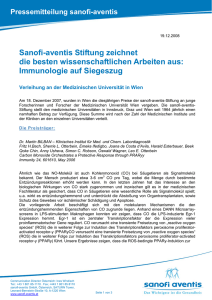Immune Control of Cytomegalovirus in the - ETH E
Werbung
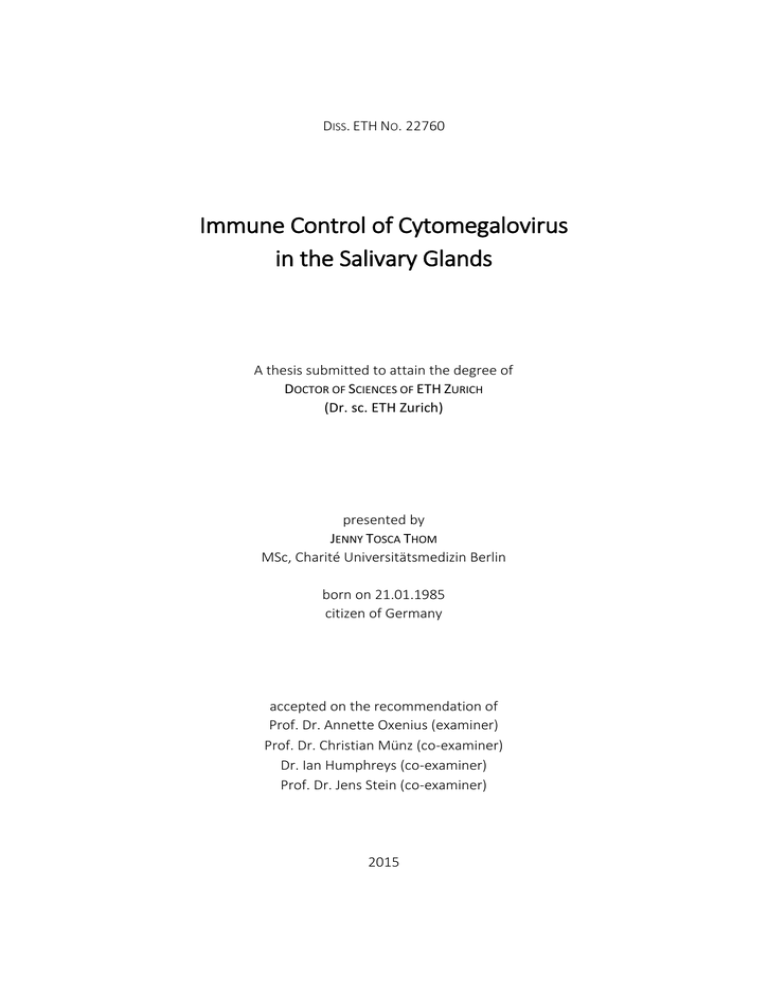
DISS. ETH NO. 22760 Immune Control of Cytomegalovirus in the Salivary Glands A thesis submitted to attain the degree of DOCTOR OF SCIENCES OF ETH ZURICH (Dr. sc. ETH Zurich) presented by JENNY TOSCA THOM MSc, Charité Universitätsmedizin Berlin born on 21.01.1985 citizen of Germany accepted on the recommendation of Prof. Dr. Annette Oxenius (examiner) Prof. Dr. Christian Münz (co-examiner) Dr. Ian Humphreys (co-examiner) Prof. Dr. Jens Stein (co-examiner) 2015 1.1 English Summary 1 General Summary English Summary Cytomegaloviruses (CMVs) are herpesviruses that establish life-long infection with alternating periods of active virus replication and latency, a state of viral dormancy. 60 – 90% of the world population is infected with human CMV (HCMV). While HCMV infection runs an asymptomatic course in immunocompetent individuals, it is a frequent cause of severe morbidity and mortality among the immunocompromised. HCMV persists selectively in mucosal tissues and exploits their secretions for horizontal spread. The saliva is the most relevant vehicle of viral transmission and CMV persists in the salivary glands (SG) far beyond the time point at which viral latency has been enforced in other organs by the host's immune response. CMVs outstanding ability to hide from the immune system at mucosal sites builds the foundation of the virus's epidemiological success. In infected cells, CMV compromises the surface expression of MHC I molecules, which are essential for recognition by activated CD8+ T cells. This process is most effective in the SG, where MHC I expression is fully suppressed in saliva producing epithelial cells, rendering CD8+ T cells entirely inoperative in the SG despite their crucial contribution to CMV control in all other organs. Instead, persistent CMV replication in the SG is contained by CD4+ T cells, which play a subordinate role in CMV control in other organs. While experimental infection of mice with murine cytomegalovirus (MCMV) has led to a profound understanding of MCMV-specific T cell responses in the SG, studies dedicated to antigen presenting cells (APCs) in this organ are scarce and inconsistent. Since APCs are important activators and regulators of CD8+ and CD4+ T cell responses, we focused in the first part of this thesis on the ontogeny and function of APCs in the SG. We found that SG-resident APCs are a network of CD11c+ CD11b+ tissue macrophages that are unable to cross-present endocytosed MCMV-derived antigen via MHC I molecules, thus failing to activate CD8+ T cells. To 5 1 General Summary our surprise, classical dendritic cells as well as inflammatory monocytes were absent from the SG at the evaluated time points. We therefore suggest that the SGspecific composition of APCs is a contributor to the severely limited efficacy of CD8+ T cells in this organ. Said shortcoming of CD8+ T cells in the SG is a universal paradigm of CMV immunity, but so far, it has been verified sufficiently only in the acute, not in the latent phase of infection. The principle mechanisms and effectors that restrict local viral reactivation and shedding during latency remain an active field of inquiry. Therefore, the second focus of this thesis was on the ability of MCMV-specific CD8+ and CD4+ memory T cells to control locally introduced MCMV in the SG. We found that the SG was immensely potent to induce CD8+ and CD4+ tissue-resident memory T (TRM) cells. The generation of TRM cells depended on cognate antigen for CD4+ but not CD8+ T cells, indicating important differences in T cell subset-specific demands within the same organ. We furthermore found that CD8+ TRM cells were able to control locally introduced MCMV. Our data therefore suggest a novel role for CD8+ T cells to restrict viral reinfection and reactivation periods in the SG, an organ that has so far been deemed resistant to CD8+ T cell-mediated virus control. 6 1.2 German Summary German Summary Cytomegalieviren (CMV) gehören zu den Herpesviren und verursachen lebenslange Infektionen, welche geprägt sind durch abwechselnde Phasen der aktiven Virusreplikation und der Latenz, einem inaktiven Ruhezustand. 60-90% der Weltbevölkerung ist mit dem humanen Cytomegalievirus (HCMV) infiziert. Während die HCMV Infektion bei immunkompetenten Individuen zumeist asymptomatisch verläuft, stellt sie für immunsupprimierte Patienten einen der häufigsten Auslöser lebensbedrohlicher Komplikationen dar. HCMV repliziert langanhaltend in sekretorischen Organen und nutzt deren Ausscheidungen für seine Übertragung. Die einzigartige Effizienz mit der das Virus in diesen Organen replizieren und aus der Latenz reaktivieren kann, trägt dabei massgeblich zu seiner hohen Prävalenz bei. Das relevanteste Übertragungssekret für CMV ist der Speichel und die andauernde Replikation in der Speicheldrüse gelingt dem Virus weit über den Zeitpunkt hinaus, an dem es in allen anderen Organen bereits durch das Immunsystem in die Latenz gezwungen wurde. In infizierten Zellen beeinträchtigt CMV die Oberflächenexpression von MHC I Molekülen, welche essenziell für die Erkennung durch aktivierte CD8+ T-Zellen sind. Diese Massnahme der Immunevasion ist besonders wirksam in der Speicheldrüse, wo sie zur vollständigen Abwesenheit von MHC I Molekülen auf infizierten speichelproduzierenden Epithelzellen führt. Letztere sind folglich unsichtbar für CD8+ T-Zellen, welche in allen anderen Organen massgeblich zur Viruskontrolle beitragen. In der Speicheldrüse hängt die Viruskontrolle nun von CD4+ T-Zellen ab, welche in anderen Organen wiederum eine untergeordnete Rolle spielen. Während T-Zellantworten in der Speicheldrüse zumindest in der akuten Phase der CMV Infektionen bereits ausführlich untersucht wurden, ist über die antigenpräsentierenden Zellen (APZ) in diesem Organ nur wenig bekannt. APZ spielen für die Aktivierung und Funktion von T-Zellen eine wichtige Rolle. Ein Fokus der Dissertation lag daher auf der Untersuchung der ontogenetischen Herkunft sowie der Funktionalität der APZ in der Speicheldrüse. Wir konnten zeigen, dass das Netzwerk der APZ ausschliesslich von Makrophagen gespannt wird, welche nicht 7 1 General Summary zur Kreuzpräsentation von MCMV-Antigenen fähig sind und folglich CD8+ T-Zellen nicht aktivieren können. Klassische dendritische Zellen, welche zur Kreuzpräsentation fähig sind, sowie inflammatorische Monozyten sind nicht Bestandteil der APZ in der Speicheldrüse. Unsere Daten deuten darauf hin, dass die spezifische Zusammensetzung des APZ-Netzwerks in der Speicheldrüse die Persistenz des Virus in diesem Organ begünstigt, indem sie zur Funktionsunfähigkeit von CD8+ T-Zellen beiträgt. Die besagte Funktionsunfähigkeit der CD8+ T-Zellen in der Speicheldrüse ist ein zentrales Dogma der CMV-Immunität, obwohl es bisher nur für die akute Phase der Virusreplikation gezeigt wurde. Sporadische Reaktivierung aus der viralen Latenz sowie Superinfektionen durch andere CMV Varianten eröffnen dem Virus jedoch wiederkehrende Möglichkeiten sich weit über die akute Phase der Infektion hinaus zu verbreiten. Ein weiteres Ziel dieser Doktorarbeit war es, die Mechanismen der Viruskontrolle im Falle einer lokalen Infektion oder Reaktivierung in der Speicheldrüse zu klären. Zu diesem Zweck haben wir monoklonale CD8+ und CD4+ T-Gedächtnisantworten in der Speicheldrüse von Mäusen mit Hilfe des mausspezifischen murinen CMV (MCMV) auf ihre Fähigkeit untersucht, eine lokal induzierte Infektion zu kontrollieren. Wir konnten zeigen, dass die Speicheldrüse das Potential besitzt, sogenannte gewebsansässige (tissue resident – TRM) CD4+ und CD8+ T-Gedächtniszellen zu bilden. Die Anwesenheit von spezifischem Antigen in der Speicheldrüse war nur für CD4+ T-Zellen, nicht aber für CD8+ T-Zellen eine zwingende Voraussetzung für die Ausbildung des TRM-Status. Zudem konnten wir zeigen, dass CD8+ TRM-Zellen entgegen unserer Erwartung in der Lage sind, lokal appliziertes MCMV zu kontrollieren. Diese Daten geben erste Hinweise auf eine bisher verkannte Funktion der CD8+ T-Zellen, virale Reaktivierungsereignisse sowie Superinfektionen in der Speicheldrüse zu überwachen. 8
